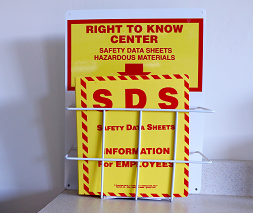Potential Health Hazards of SPF Chemicals
 It is imperative that you follow all safety and health guidelines when applying spray polyurethane foam (SPF) and read all information contained in your supplier’s Safety Data Sheet (SDS) for the SPF product you are using before work begins. SDSs are the primary sources of extensive and specific information on methylene diphenyl diisocyanate (MDI), polymeric MDI (PMDI) and other spray polyurethane system ingredients. In addition, CPI, the Spray Polyurethane Foam Alliance (SPFA), federal agencies and member companies offer various guidance documents intended to help educate SPF applicators about safe use and handling practices. Many different variables are present during SPF application, so each case should be evaluated individually so that appropriate protection can be afforded.
It is imperative that you follow all safety and health guidelines when applying spray polyurethane foam (SPF) and read all information contained in your supplier’s Safety Data Sheet (SDS) for the SPF product you are using before work begins. SDSs are the primary sources of extensive and specific information on methylene diphenyl diisocyanate (MDI), polymeric MDI (PMDI) and other spray polyurethane system ingredients. In addition, CPI, the Spray Polyurethane Foam Alliance (SPFA), federal agencies and member companies offer various guidance documents intended to help educate SPF applicators about safe use and handling practices. Many different variables are present during SPF application, so each case should be evaluated individually so that appropriate protection can be afforded.
What are potential health hazards of SPF chemicals?
While we cannot review all the potential health effects that could result from spray foam chemicals here — and this specific information would be contained in the product SDS — you should understand that a worker could be exposed to SPF chemicals by breathing chemical mists or vapors, skin or eye contact, or ingestion. A few key points are presented here.
A-Side – Inhalation overexposure can cause 1) irritation of the nose, throat, and lungs, causing runny nose, sore throat, coughing, tightness in the chest, and shortness of breath, and 2) respiratory tract sensitization (e.g., the development of asthma) with symptoms of chest tightness, shortness of breath, coughing, and/or wheezing. An asthma attack can be life-threatening. NIOSH notes that “early recognition of sensitization and prompt and strict elimination of exposures is essential to reduce the risk of long-term or permanent respiratory problems for workers who have become sensitized.”
Skin contact can cause 1) irritation, and 2) sensitization (allergy). Symptoms include reddening, itching, swelling, and rash. Skin contact alone may lead to respiratory sensitization.
Eye contact can cause reddening, tearing, stinging, and/or swelling of the eyes.
B-Side – Inhalation overexposure can cause irritation of the respiratory tract, causing cough, sore throat, and runny nose. Irritation of the eyes (liquid or vapor) and skin (liquid) are also possible. In addition, skin contact with some amine catalysts may lead to skin sensitization. Cardiac arrhythmia (irregular heartbeat) is a symptom of overexposure to certain blowing agents. In addition, the vapors of some amine catalysts can temporarily cause vision to become foggy or blurry, and halos may appear around bright objects such as lights. It is critical to avoid inhalation of, and skin and eye contact with, SPF chemicals.
Refer to your supplier’s Safety Data Sheets (SDS) for a complete listing of the composition and potential health effects of A and B-side chemicals.
Where can I get more information?
A comprehensive resource containing more information is the ACC CPI Health and Safety Product Stewardship Workbook for High-Pressure Application of SPF and accompanying Presentation materials.
- American Chemistry Council (ACC):
- ACC Center for the Polyurethanes Industry (CPI) – Select “Health, Safety and Product Stewardship”
- ACC Diisocyanates Panel (DII)
- U.S. Environmental Protection Agency (EPA) Design for the Environment (DfE) – Spray Polyurethane Foam
- Spray Polyurethane Foam Alliance (SPFA) – Select “Health & Safety”
- U.S. National Institute of Occupational Safety and Health (NIOSH) – Safety and Health Topic: Isocyanates
- Safety Data Sheets and other health and safety literature can be obtained by contacting your spray polyurethane foam supplier.
